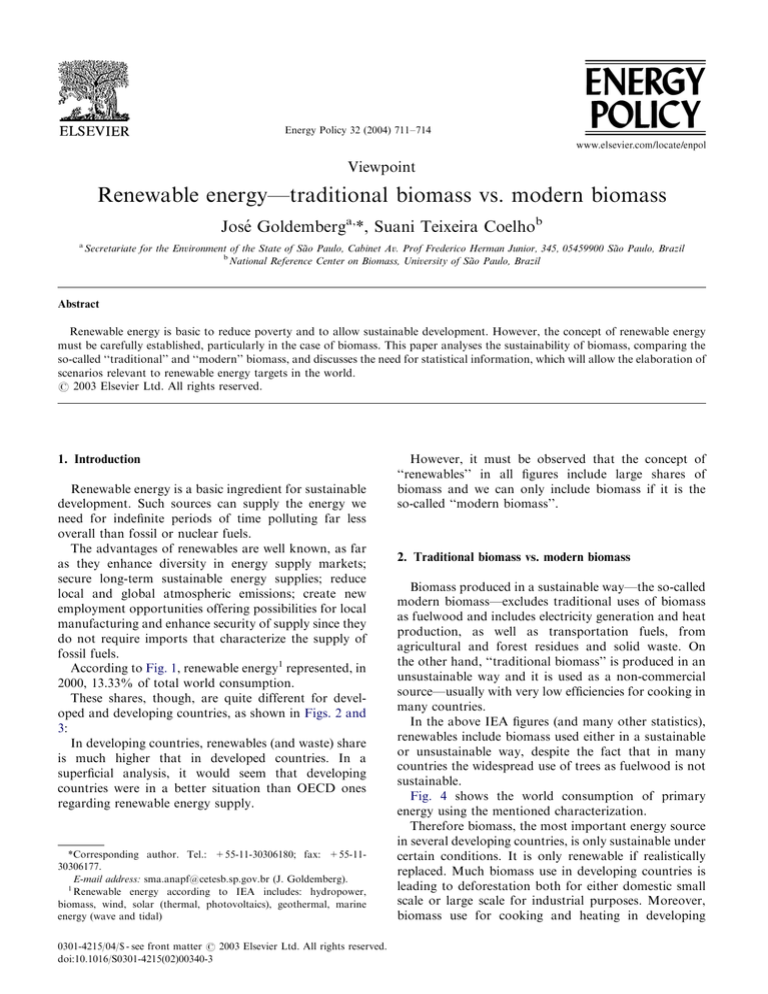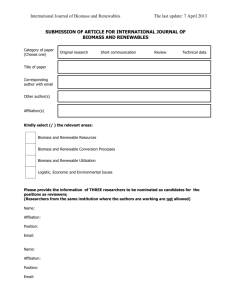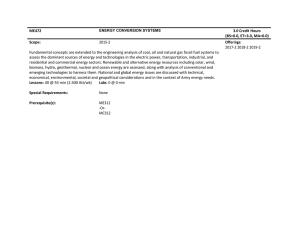
ARTICLE IN PRESS
Energy Policy 32 (2004) 711–714
Viewpoint
Renewable energy—traditional biomass vs. modern biomass
Jose! Goldemberga,*, Suani Teixeira Coelhob
a
Secretariate for the Environment of the State of Sao
* Paulo, Cabinet Av. Prof Frederico Herman Junior, 345, 05459900 Sao
* Paulo, Brazil
b
National Reference Center on Biomass, University of Sao
* Paulo, Brazil
Abstract
Renewable energy is basic to reduce poverty and to allow sustainable development. However, the concept of renewable energy
must be carefully established, particularly in the case of biomass. This paper analyses the sustainability of biomass, comparing the
so-called ‘‘traditional’’ and ‘‘modern’’ biomass, and discusses the need for statistical information, which will allow the elaboration of
scenarios relevant to renewable energy targets in the world.
r 2003 Elsevier Ltd. All rights reserved.
1. Introduction
Renewable energy is a basic ingredient for sustainable
development. Such sources can supply the energy we
need for indefinite periods of time polluting far less
overall than fossil or nuclear fuels.
The advantages of renewables are well known, as far
as they enhance diversity in energy supply markets;
secure long-term sustainable energy supplies; reduce
local and global atmospheric emissions; create new
employment opportunities offering possibilities for local
manufacturing and enhance security of supply since they
do not require imports that characterize the supply of
fossil fuels.
According to Fig. 1, renewable energy1 represented, in
2000, 13.33% of total world consumption.
These shares, though, are quite different for developed and developing countries, as shown in Figs. 2 and
3:
In developing countries, renewables (and waste) share
is much higher that in developed countries. In a
superficial analysis, it would seem that developing
countries were in a better situation than OECD ones
regarding renewable energy supply.
*Corresponding author. Tel.: +55-11-30306180; fax: +55-1130306177.
E-mail address: sma.anapf@cetesb.sp.gov.br (J. Goldemberg).
1
Renewable energy according to IEA includes: hydropower,
biomass, wind, solar (thermal, photovoltaics), geothermal, marine
energy (wave and tidal)
0301-4215/04/$ - see front matter r 2003 Elsevier Ltd. All rights reserved.
doi:10.1016/S0301-4215(02)00340-3
However, it must be observed that the concept of
‘‘renewables’’ in all figures include large shares of
biomass and we can only include biomass if it is the
so-called ‘‘modern biomass’’.
2. Traditional biomass vs. modern biomass
Biomass produced in a sustainable way—the so-called
modern biomass—excludes traditional uses of biomass
as fuelwood and includes electricity generation and heat
production, as well as transportation fuels, from
agricultural and forest residues and solid waste. On
the other hand, ‘‘traditional biomass’’ is produced in an
unsustainable way and it is used as a non-commercial
source—usually with very low efficiencies for cooking in
many countries.
In the above IEA figures (and many other statistics),
renewables include biomass used either in a sustainable
or unsustainable way, despite the fact that in many
countries the widespread use of trees as fuelwood is not
sustainable.
Fig. 4 shows the world consumption of primary
energy using the mentioned characterization.
Therefore biomass, the most important energy source
in several developing countries, is only sustainable under
certain conditions. It is only renewable if realistically
replaced. Much biomass use in developing countries is
leading to deforestation both for either domestic small
scale or large scale for industrial purposes. Moreover,
biomass use for cooking and heating in developing
ARTICLE IN PRESS
J. Goldemberg, S. Teixeira Coelho / Energy Policy 32 (2004) 711–714
712
World Energy 1998 (WEA 2000) from 402 EJ TPES
World shares of total primary energy supply (2000)
414.6 EJ
fossil fuels
79.60%
fossil fuels
79.83%
nuclear
6.47%
renewables and
waste
10.52%
geothermal,
solar etc.
0.53%
nuclear
6.83%
hydro
2.28%
Fig. 1. World shares of TPES—total primary energy supply (IEA,
2001a, b).
traditional
biomass
(partially
renewable)
9.45%
new
renewables
0.50%
large hydro
2.25%
modern
biomass
1.73%
"new" renewables
2.23%
renewables
4.48%
(plus a share of traditional biomass)
Fig. 4. World energy consumption in 1998 (TPES) (WEA, 2000).
Total Primary Energy Supply (2000) in OECD
countries (222.6 EJ)
fossil fuels
82.81%
renewables and
waste
3.39%
geothermal,
solar etc.
0.67%
hydro
2.13%
nuclear
11.01%
Fig. 2. Shares of TPES in developed countries as of 1998 (IEA,
2001b).
Non-OECD countries (192.0 EJ)
fossil fuels
76.39%
nuclear
1.99%
renewables
and waste
18.79%
geothermal,
solar etc.
0.36%
hydro
2.47%
Fig. 3. Shares of TPES in developing countries 1998 (IEA, 2001a).
countries is a major cause of serious indoor pollution,
particularly to women, small children and the elderly.
On the other hand, in OECD countries (Fig. 2) most
biomass used is modern biomass, from wood plantation,
wood, urban or rural residues.
For developing countries the situation may be more
complex. As seen in Fig. 3 they use a lot of ‘‘renewable
and waste’’ energy (18.79%), a good part of which is not
strictly sustainable. However, the huge difficulty is to
obtain the desegregated figures in order to allow the
effective evaluation of the current situation in each
country. In many of them, however, ‘‘modern or
sustainable biomass’’ is already significant and could
be easily increased. Examples are Brazil (20.4%, Fig. 5)
and India (4.7%) among others.
Economic development will at first encourage
developing countries to reduce their use of biomass
either through efficiency improvements and fuel switch,
which may reduce deforestation but will not lead
necessarily to sustainability. Economic development will
also inevitably lead to some increase in the use of fossil
fuels.
Fig. 6 shows growth rates for the different types
of renewable energy and an extrapolation to 2003
and 2008 assuming these growth rates will be the
same as they were in the period 1993–1998, with the
adequate differentiation between traditional and
modern biomass.
This figure was the basis for the Brazilian Energy
Initiative, presented at the WSSD, in Johannesburg,
proposing an increase of ‘‘the use of new renewable
sources to 10% as a share of world energy matrix by
2010’’. In this proposal, ‘‘new renewable sources’’
include modern biomass, small hydropower, geothermal
ARTICLE IN PRESS
J. Goldemberg, S. Teixeira Coelho / Energy Policy 32 (2004) 711–714
713
Brazilian Total Primary Energy Supply, by Energy Type, 2000
Nuclear
1.2%
Oil
47.1%
Coal
7.4%
Traditional biomass
(unsustainable)
3.4%
Natural gas
5.5%
"New " renewables
2.2%
"Modern" biomass
11.3%
"New renewable energy sources"
13.5%
Large hydro
12.8%
Traditional biomass
(renewable)
9.1%
Renewable energy sources
35.4%
Fig. 5. Brazilian energy shares (adapted from WEA, 2000 and CENBIO, 2001).
World Renewables - TPES and shares
Source:
WEA 2000. Projections upon yearly rate of increase by source
(2.89% for renewables and 3.73% for new renewables)
25
5.0%
4.5%
20
4.0%
15
3.0%
large hydro
9 EJ (2.2%)
2.5%
10
2.0%
new renewables
2 EJ (0.5%)
% of 1998 TPES (402 EJ)
Total Primary Energy Supply (EJ)
3.5%
1.5%
5
1.0%
modern biomass
7 EJ (1.7%)
0.5%
0
0.0%
1993
1998
2003
2008
year
solar thermal electricity (5% /yr)
biomass electricity (3% /yr)
biomass heat (3% /yr)
biomass ethanol (3% /yr)
wind electricity (30% /yr)
solar PV electricity (30% /yr)
solar low temperature heat (8% /yr)
geothermal electricity (4% /yr)
geothermal heat (6% /yr)
marine tidal (n.a.)
small hydro (3% /yr)
large hydro (2% /yr)
Fig. 6. World renewables—TPES and shares (adapted from WEA, 2000).
energy, wind energy, solar energy (including photovoltaics) and marine energy. As already mentioned,
‘‘modern biomass’’ excludes traditional uses of biomass
as fuelwood and includes electricity generation and heat
production from agricultural and forest residues and
solid waste. With such caveats ‘‘new renewable energy
sources’’ could be labeled as ‘‘sustainable renewable
energy sources’’.
ARTICLE IN PRESS
714
J. Goldemberg, S. Teixeira Coelho / Energy Policy 32 (2004) 711–714
References
CENBIO, 2001. The Brazilian National Reference Center on Biomass.
Private communication, 2000.
IEA Energy Balances of non-OECD Countries, 2001a. International
Energy Agency, 2002.
IEA Energy Balances of OECD Countries, 2001b. International
Energy Agency, 2002.




